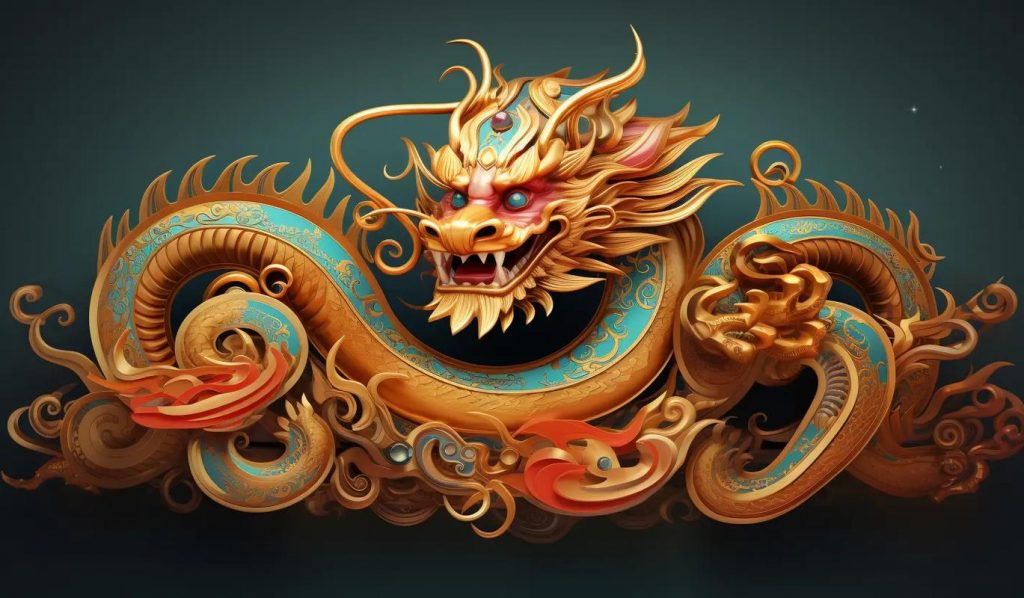
There are significant differences between Chinese dragons and Western dragons. These differences are not only reflected in appearance, but are also deeply rooted in their respective cultural backgrounds, historical evolution and symbolic meanings. The following will explain in detail why Chinese dragons are not like Western dragons from many aspects.
- Origin and evolution
Chinese dragon:
Origin: The origin of the Chinese dragon can be traced back to ancient times. It is the ancient people’s multifaceted understanding of various animals in nature (such as snakes, crocodiles, lizards, fish, deer, bears, etc.) and celestial phenomena (such as thunder, clouds, rainbows, etc.) And the created fetish. It embodies the ancestors’ deification and sublimation of natural forces and is an important part of ancient Chinese myths and legends.
Evolution: The image of the dragon has continued to evolve over the course of history, from simple forms in the early days to complex and diverse forms later on. In different historical periods and cultural backgrounds, the image and symbolic meaning of dragons are also different. But in general, the Chinese dragon has always maintained its majestic, sacred and auspicious qualities.
Dragon:
Origin: The origin of the Western dragon is equally ancient, but its image is more associated with natural objects such as poisonous snakes, bats, and crocodiles. In ancient Greek and Roman mythology, and later in Christian culture, dragons came to be portrayed as symbols of evil.
Evolution: Over time, the image of the Western dragon became fixed, often described as a creature with a puma-like body, huge bat wings or feathers, four legs, horns, and scales. Its image is often associated with evil, destruction and power.
- Appearance
Chinese dragon:
Physical Characteristics: The Chinese dragon’s body is usually depicted as long and sinuous, with scales and horns, and strong and powerful limbs. Their heads vary in shape, but usually have features such as antlers, a cow’s nose, a donkey’s mouth, and shrimp eyes. The scales of the dragon are delicate and lustrous, and the overall image is majestic and sacred.
Color: The colors of Chinese dragons are diverse, but bright colors such as gold and red are the main ones. These colors not only add to the mystery of the dragon, but also reflect its symbolic meaning of auspiciousness and wealth.
Dragon:
Physical characteristics: Western dragons are usually larger and bulkier, with a body structure similar to that of a puma and four strong legs. Its head is shaped like a horse or snake, with sharp horns and sharp teeth. The dragon’s wings are wide and powerful, able to support its huge body in flying.
Color: The colors of Western dragons are mainly green, red or gold, and these colors often echo their evil and destructive image.
- Symbolic meaning
Chinese dragon:
Auspicious talisman: In Chinese culture, the dragon is a symbol of auspiciousness and wealth. It represents good luck, success and happiness. In traditional festivals and celebrations, the image of the dragon is often used in decorations and performances to pray for good luck.
Symbol of imperial power: Since the Qin and Han Dynasties, the dragon has gradually become a symbol of imperial power. The emperor called himself the “True Dragon Emperor” and wore a dragon robe embroidered with dragon patterns. The image of the dragon is widely used in palace architecture, sculpture and painting to demonstrate the majesty and sanctity of imperial power.
Cultural symbol: The Chinese dragon is not only the broad totem and spiritual symbol of the Chinese nation, but also one of the important symbols of Chinese culture. It represents the wisdom, strength and courage of the Chinese nation.
Dragon:
Symbol of evil: In Western culture, the dragon is usually a symbol of evil, destruction and disaster. It represents evil forces, dark forces and the threat of death. In literature, art, film and television, dragons are often depicted as villains or monsters.
Symbol of Power: Although the Western dragon is viewed as a symbol of evil, its immense strength and magical abilities are often awe-inspiring. In some cultures, the dragon is also seen as one of the symbols of gods or elements.
- Cultural background and influence
Chinese dragon:
Taoism and Confucian culture: Chinese dragons are influenced and nourished by Taoism and Confucian culture. They take “the unity of nature and man” as their philosophical basis and group harmony as their cultural standard. It contains spiritual qualities such as diversity and inclusion, benefiting all living beings, and peaceful coexistence.
Historical inheritance: The image and symbolic meaning of the Chinese dragon have been widely inherited and developed throughout history. It not only affects China’s traditional culture and artistic creation, but also profoundly affects the Chinese people’s ideas and behaviors.
Dragon:
Christian culture: In Western culture, the image of the dragon is closely linked to Christian culture. Christianity regards the dragon as a symbol of evil and the incarnation of the devil, demonizing it through religious stories and works of art. This concept has had a profound impact on Westerners’ ideas and behaviors.
Cultural influence: Although the dragon is regarded as a symbol of evil in Western culture, its image is still widely used in literature, art, film and television works. These works not only enrich the connotation and expression of Western culture, but also promote the exchange and integration of Eastern and Western cultures.
The differences between Chinese dragons and Western dragons (Dragon) stem from many aspects such as their origin, evolution, appearance, symbolic meaning, and cultural background. These differences not only reflect the differences and diversity of Eastern and Western cultures, but also provide us with rich materials and perspectives for understanding and appreciating different cultures.
